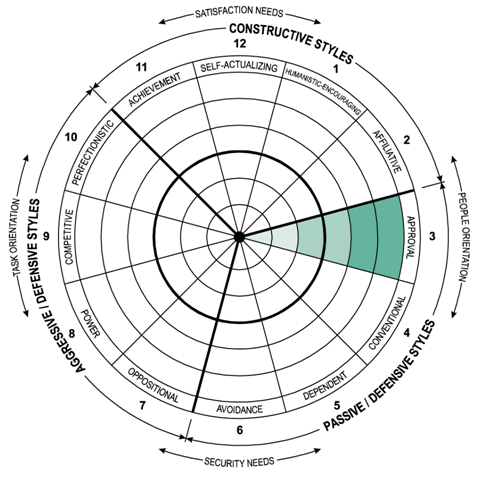In a previous article, we introduced the Human Synergistics Circumplex™, a proven framework to measure, report, discuss and better understand individual and collective human behaviour, and their impact upon business and organisational performance (refer: Catching Smoke: A Proven Framework for Addressing Culture and Leadership).
This latest article focuses on one of the Passive/Defensive styles – Approval: what it’s all about, how it can hinder your personal effectiveness and/or the performance of your business/organisation and how to, at a personal and/or workplace culture level, reduce excessive Approval-oriented thinking and behaviour.

So Just What is the Approval Style?
Whether we’re looking at it from an individual leadership or broader workplace culture perspective, the Approval style is characterised by a tendency to do things and make decisions based on a need to be accepted and liked by others, as opposed to taking action/making decisions that will drive the best outcome.
Leaders who are personally high in the Approval style will tend to, for example:
- tell others what they think they want to hear
- often supress their true feelings/thoughts
- try hard to gain the acceptance of others before they make decisions, and feel overly-anxious if they need to make a decision that does not have full acceptance, and
- are very uncomfortable with conflict and confrontation.
Workplace cultures can themselves become Approval-oriented, with participants feel expected or implicitly required to, for example:
- just “go along” with others and not express an alternate view
- not point out problems and weaknesses
- “stay on the good side” of their bosses
- avoid conflict and confrontation, and do what they need to do to keep the peace, and
- make decisions on the basis that the key and overriding objective is to please others.
So Why Should I Focus on Limiting the Approval Style?
While a low level of Approval thinking and behaviour will generally not be detrimental, too much can be damaging at both individual and organisational levels.
Indeed, research over several decades by Human-Synergistics has consistently shown that leaders and workplaces cultures high in Approval and other defensive styles tend to be significantly less effective, particularly in the longer-term, than those with predominantly Constructive styles.
From a workplace culture perspective for example, primarily Constructive workplaces:
- are 32% more able to effectively respond to changes in the external environment
- achieve 32% higher quality performance
- demonstrate 28% more effective teamwork
- have a 25% greater commitment to producing a quality result
- include individuals that are 32% more motivated, 26% more satisfied and 25% more likely to stay with the organisation.
Rather than the focus being on achieving the best possible outcomes (be they long-term productivity and profitability, performance, quality or customer satisfaction, for example), Approval-oriented individuals and cultures are most concerned with simply “pleasing others”. At a practical level, this might manifest itself in a number of ways, including for example:
- -managers not having difficult discussions with team members even where performance is below the required standard
- -fewer ideas/suggestions coming forward because it’s just expected that we “go along” with what the boss has suggested
- -necessary but difficult decisions (eg. restructuring), not being taken for fear of upsetting others, and/or
- -dissatisfaction or demotivation as, over time, individual needs become subordinate to those of others.
Controlling Approval Thinking and Behaviour
If you think you could improve your effectiveness as a leader by limiting your Approval thinking and behaviour, try for example:
- Seeking support if you need to, to tackle the difficult conversations and make the difficult decisions you need to make to improve performance
- Accepting that leadership roles sometimes involve difficult conversations and decisions. Most people understand that and accept it. Indeed, many people prefer an honest, direct approach rather than “wishy washy” leadership
- Voicing your own opinions more, particularly if you have a contrary view
- Learning to identify and address approval-oriented communication habits (eg. not looking people in the eye or overusing qualifiers such as “It’s just an idea, but…..”, “What do you think if…”).
To control Approval thinking and behaviours at a collective/workplace level, consider:
- Making a point to recognise and value contrary opinions and ideas, let people know that “it’s OK” to have different opinions and ideas
- Communicate your intent to other managers, begin to tackle the difficult conversations and issues, and build the expectation that they need to do the same
- Provide support and training to managers, to help them meet your expectations, and
- Welcome and value those who point out genuine problems and flaws (after all, it’s an opportunity to improve your business).
We’ll continue in future articles to look at the what, why and how of other workplace culture and personal leadership styles. In the meantime, be sure to call if you’d like to explore the range of culture and leadership programs we have available to help transform your people, your team and your business/organisation.
If you’ve missed our previous articles on the other styles, be sure to check out our blog – look for the “Focus on Culture and Leadership” series of articles.

